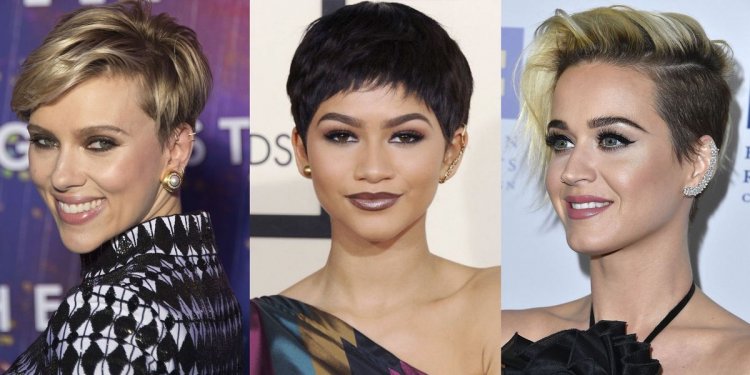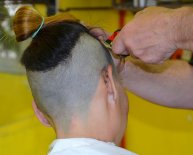
Short haircuts in style
 We need to talk about a haircut. Also about identity, and hatred, and maybe about the total end of American civilization — but first about a haircut.
We need to talk about a haircut. Also about identity, and hatred, and maybe about the total end of American civilization — but first about a haircut.
You have seen it. It is short on the sides and long on the top. It is clean and tidy, with a military sheen. It’s been popular among young people for several years. But now this haircut is making us ask ourselves, with seriousness that seems unthinkable in 2016: hipster or Nazi?
Young city-dwelling men leaving their SoulCycle classes in leftover “I’m With Her” T-shirts.
Young white-nationalism enthusiasts leaving a recent conference in Washington, D.C., where several of them performed a Nazi salute.
The same haircut. The exact same haircut.
In the 1930s, Nazis distinguished themselves by wearing swastikas, an easily identifiable marker that made their odious politics clear. The only defining look of today’s white nationalists — a movement that seeks to form a whites-only state — is the haircut, so popular that the leader of one nationalist group tweets under the handle “Fashy Haircut, ” short for “fascist.” And there’s nothing inherently wrong with the haircut — as noted, lots of other guys are wearing it these days, too. But that’s what makes it scary.
Richard Spencer, the carefully crafted face of the self-described “alt-right, ” organized a conference of white-nationalism believers. (Linda Davidson/The Washington Post)
 For the past half-decade, the haircut, when worn by hipsters, has been known jokingly as the “Hitler Youth, ” at least according to a 2011 New York Times fashion article, because of its resemblance to the style popular during Germany’s Third Reich. That off-color nickname, one assumes, started in a different political climate, when it seemed we could be a bit cavalier and ironic with such terminology. Back before we started seeing the haircut on literal white nationalists.
For the past half-decade, the haircut, when worn by hipsters, has been known jokingly as the “Hitler Youth, ” at least according to a 2011 New York Times fashion article, because of its resemblance to the style popular during Germany’s Third Reich. That off-color nickname, one assumes, started in a different political climate, when it seemed we could be a bit cavalier and ironic with such terminology. Back before we started seeing the haircut on literal white nationalists.
Promoters of white nationalism — or the “alt-right, ” as some call it — are coming out of the woodwork now. They say they have been emboldened by Donald Trump’s various calls to ban Muslim immigration into this country and deport millions of undocumented Latin Americans. They have a leader in a man named Richard Spencer, who wears the haircut along with his three-piece Brooks Brothers suits. It’s Hitler Youth rebranded as Hitler Yuppie — an insidious way to blend in.
“I posted on Facebook yesterday that it’s probably time to think about getting rid of my haircut, ” says Joseph Phelan, a community organizer and anti-racism activist who lives in Brooklyn and acquired the haircut several years ago at an old-fashioned barber shop. Phelan read a profile on Spencer and was dismayed to learn his haircut is fondly if ironically referred to by many wearers as a “fashy.”
Young men sporting semi-shaved haircuts at the November conference hosted by Richard Spencer’s National Policy Institute in Washington. (Linda Davidson/The Washington Post)
 Phelan thinks it’s useful for white nationalists to sport a costume of sorts, so that they might be recognized by the rest of the population. He knows that being upset about a haircut is really being upset about their insidious infiltration into society. “I really wish they would get off my haircut, and get off my people.”
Phelan thinks it’s useful for white nationalists to sport a costume of sorts, so that they might be recognized by the rest of the population. He knows that being upset about a haircut is really being upset about their insidious infiltration into society. “I really wish they would get off my haircut, and get off my people.”
The style has its origins in Victorian England, when it was worn by young hooligans known as “scuttlers, ” but is most commonly affiliated with the Nazi youth movement of the 1930s and ’40s. Adolf Hitler had a version of it — with a floppy, greasy forelock — and so did his close associate Heinrich Himmler, and so did any young man in a Hitler Youth recruitment poster. Apparently, soldiers requested it because it eased the wearing and removing of their helmets. Flash-forward 70-plus years and there were a whole bunch of those haircuts together at the recent conference of Spencer’s National Policy Institute, worn by men who feel their whiteness has been infringed upon by the “cultural Marxism” of the Americas:
— IDENTITY EVROPA (@IdentityEvropa)
There’s an ironic issue with these men wearing this haircut: Since its long-ago heyday, it has been claimed by others, who are not at all connected to fascist worldview. Quite the opposite. Beginning around 2010 or 2011, it became the haircut of Macklemore, the Seattle rapper. It became the haircut of several cast members of “Glee, ” as well as David Beckham.
Macklemore and DJ/producer Ryan Lewis in Los Angeles in 2014. (Ari Perilstein/Getty Images for T-Mobile)
The haircut that long ago appealed to the Nazis became, more recently, the choice of fashionable young liberal men, gay and straight. Celebrities sent their high-and-tights, as they called them, around the globe, spawning a generation of imitators and obligatory trend pieces, which noted in 2011 that it had become the preferred cut for the well-coiffed, well-clad, crunchy cosmopolitan.
Brad Pitt, high and tight at the 2014 Oscars. (Frederic J. Brown/AFP/Getty Images)
Adam Levine, right, with the requisite supermodel wife and sleek undercut at the 2015 Academy Awards. (Jordan Strauss/Invision/AP)



















